1994 CADILLAC ELDORADO weight
[x] Cancel search: weightPage 110 of 398
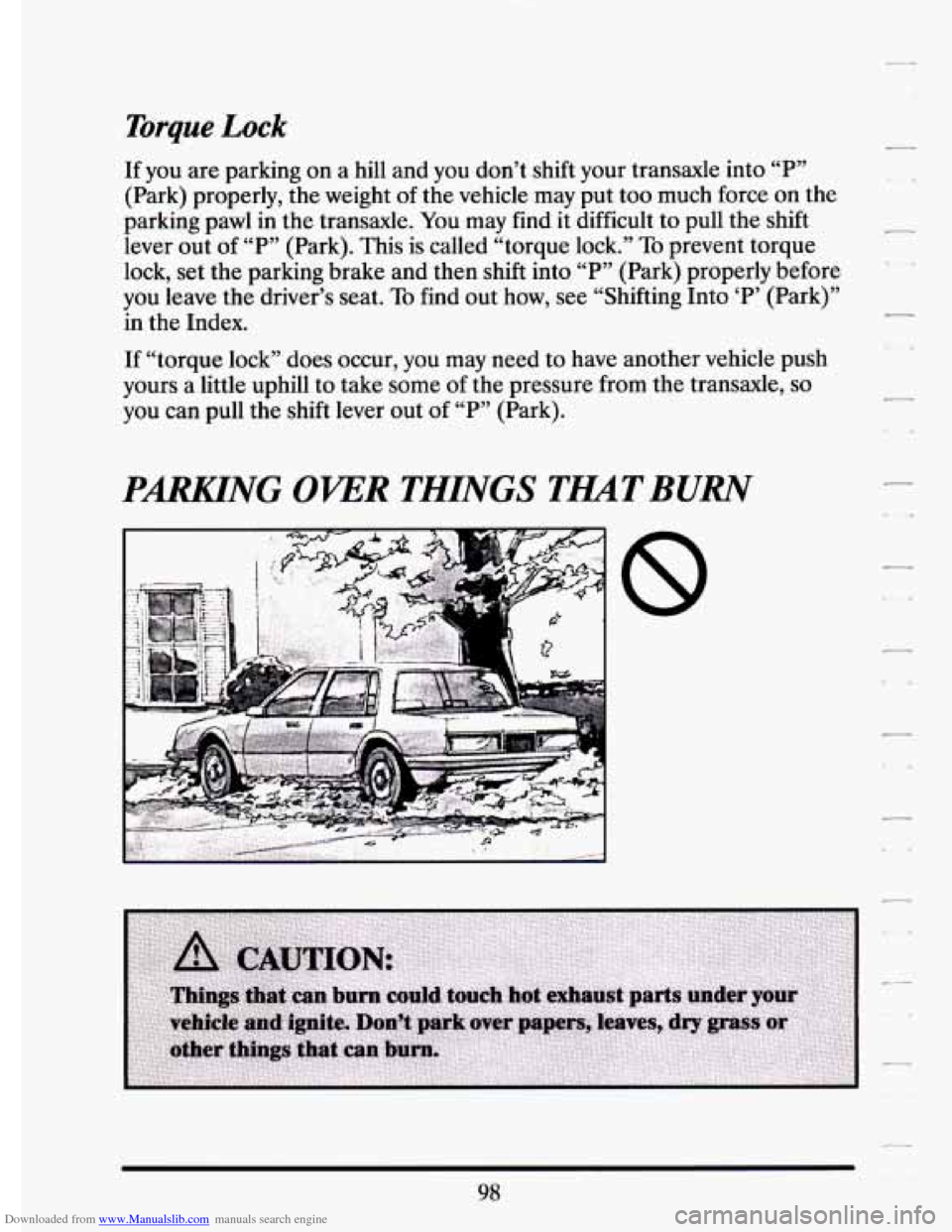
Downloaded from www.Manualslib.com manuals search engine Torque Lock
If you are parking on a hill and you don’t shift your transaxle into “P”
(Park) properly, the weight
of the vehicle may put too much force on the
parking pawl in the transaxle. You may find it difficult to pull the shift
lever out of “P” (Park). This is called “torque lock.”
To prevent torque
lock, set the parking brake and then shift into
“P” (Park) properly before
you leave the driver’s seat.
To find out how, see “Shifting Into ‘P’ (Park)”
in the Index.
If ‘?.orque lock” does occur, you may need to have another vehicle push
yours
a little uphill to take some of the pressure from the transaxle, so
you can pull the shift lever out of “P” (Park).
PARKING OKER THINGS TMTBURN
,,
-
98
Page 183 of 398
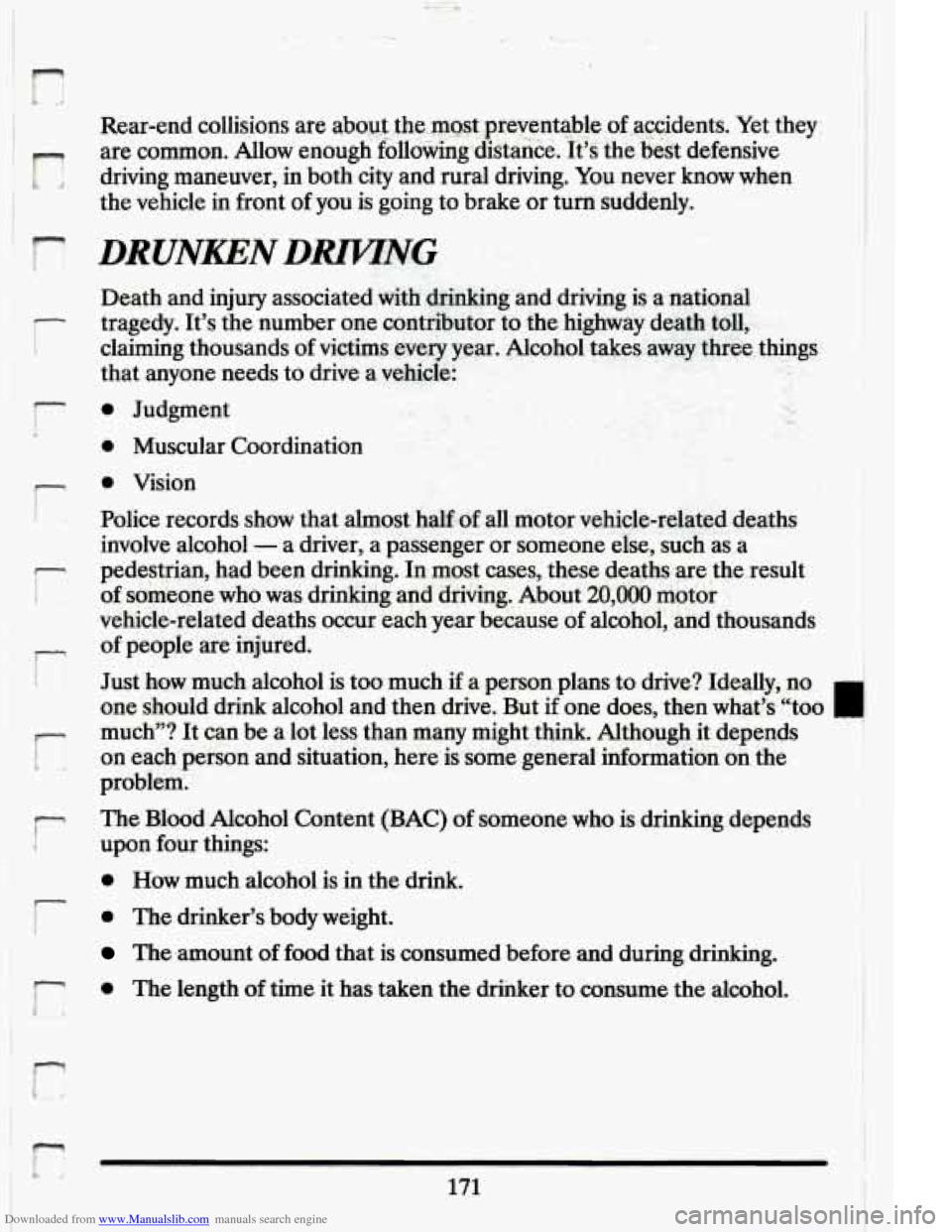
Downloaded from www.Manualslib.com manuals search engine r
i !
1‘
I:
r
r
Rear-end collisions are qbrrJt.;the m~$t puwentable .oS_aqidents. Yet they:
are common.
Allow enough foll&g!disiance. It s ,the’be$t defensive
driving maneuver, in both city and
rural driving. You never know when
the vehicle in front
of you is going to brake or turn suddenly.
.k,; 4,:w: , s.7,- ”,, 9 x..:.’. ’
The Blood AlcohoKontent (BAC) of someone who is drinking..depends
upon four things:
0 How much alcohol is in the drink.
0 The drinker’s body weight.
The amount of food th,at is consumed before and during drinking.
0 The length of time it has taken the drinker to consume the alcohol.
Page 185 of 398
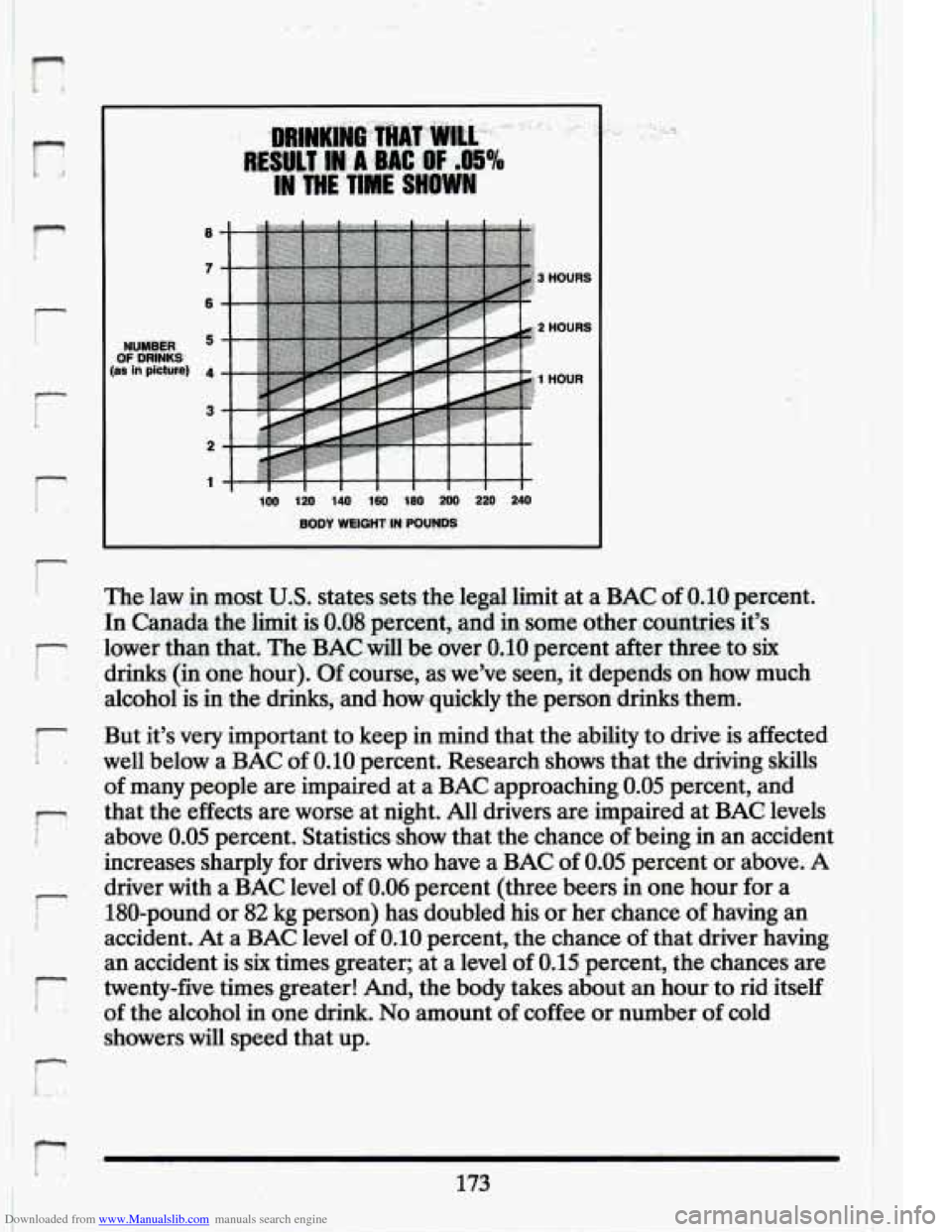
Downloaded from www.Manualslib.com manuals search engine p i.
r
t
f-
!
r
!
OF DRINKS
NUMQER [as in picture)
HOURS
HOURS
HOUR ._.
100 120 140 160 180 200 2M 240
800Y WEIGHT-
IN POUNDS
Page 213 of 398
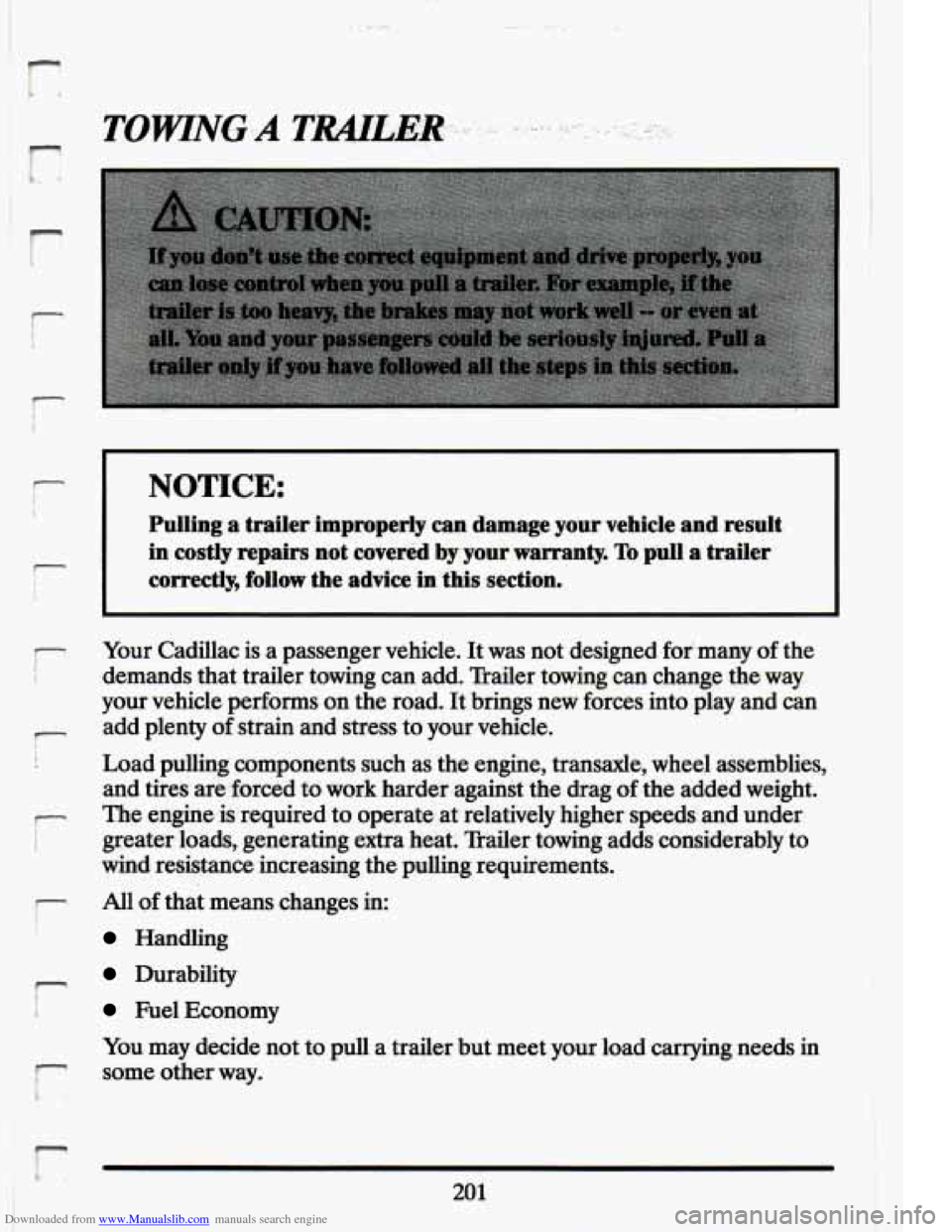
Downloaded from www.Manualslib.com manuals search engine r
r
r
P
r
!
r I
r
r-
NOTICE:
Pulling a trailer improperly can damage your vehicle and result
in costly repairs not covered by your warranty. To pull a trailer
correctly, follow the advice
in this section.
Your Cadillac is a passenger vehicle. It was not designed for many of the
demands that trailer towing can add.. Trailer towing can change the way
your vehicle performs on the road. It brings new forces into play and can
add plenty
of strain and stress to your vehicle.
Load pulling components such as the engine, transaxle, wheel assemblies,
and tires are forced to work harder against the drag
of the added weight.
The engine is required to operate at relatively higher speeds and under
greater loads, generating extra heat. Trailer towing adds considerably to
wind resistance increasing the pulling requirements.
All
of that means changes in:
Handling
Durability
Fuel Economy
You may decide not to pull a trailer but meet your load carrying needs in
some other way.
201 I
I
Page 214 of 398
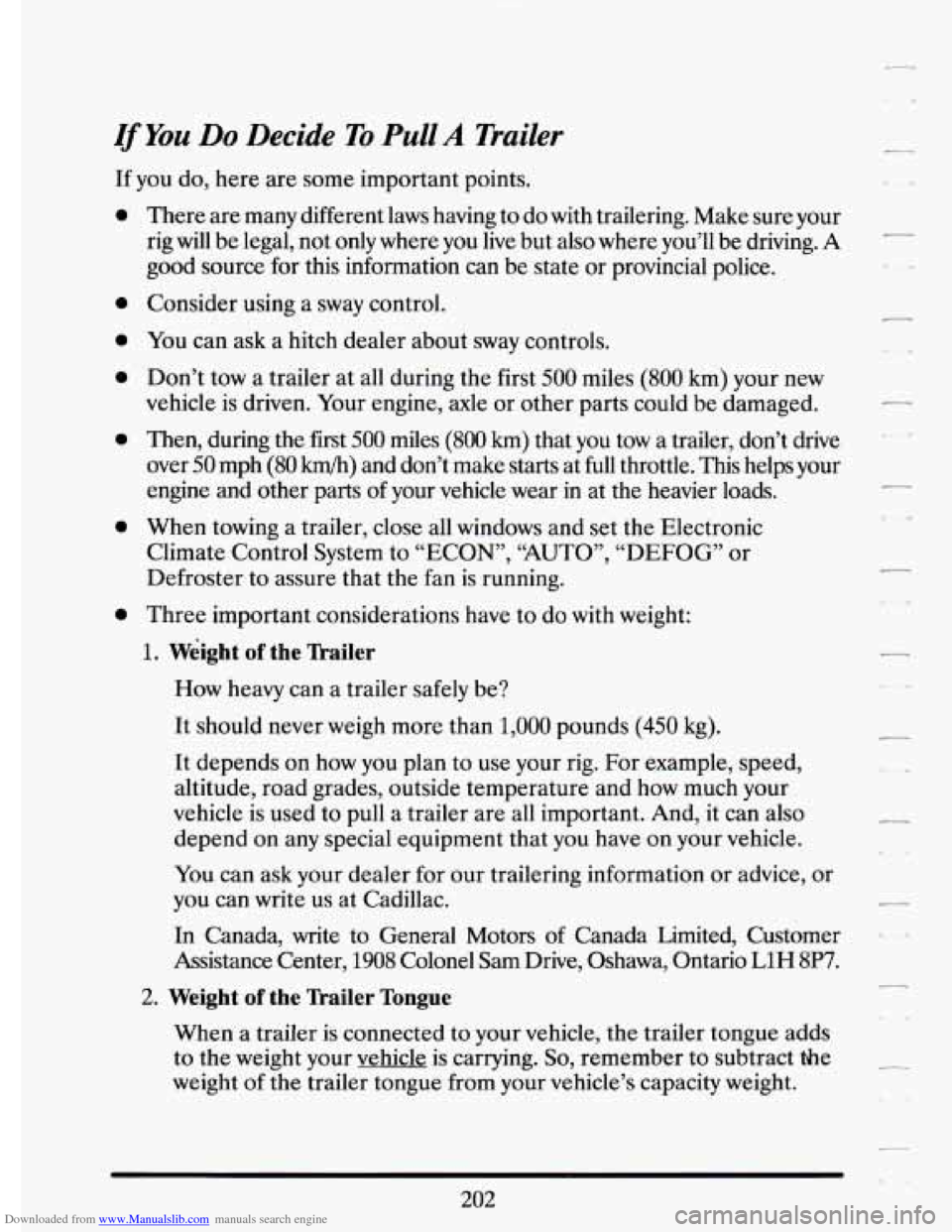
Downloaded from www.Manualslib.com manuals search engine If You Do Decide To Pull A Trailer
If you do, here are some important points.
0
0
0
e
0
0
0
There are many different laws having to do with trailering. Make sure your
rig will be legal, not
only where you live but also where you’ll be driving. A
good source for this information can be state or provincial police.
Consider using
a sway control.
You can ask a hitch dealer about sway controls.
Don’t tow a trailer at all during the first
500 miles (800 km) your new
vehicle is driven. Your engine, axle or other parts could be damaged.
Then, during the first
500 miles (800 km) that you tow a trailer, don’t drive
over
50 mph (80 km/h) and don’t make starts at full throttle. This helps your
engine and other parts of your vehicle wear in at the heavier loads.
When towing a trailer, close all windows and set the Electronic
Climate Control System to
“ECON”, “AUTO”, “DEFOG” or
Defroster to assure that the fan is running.
Three important considerations have to do with weight:
1. Weight of the nailer
How heavy can a trailer safely be?
It should never weigh more than 1,000 pounds
(450 kg).
It depends on how you plan
to use your rig. For example, speed,
altitude, road grades, outside temperature and how much your
vehicle is used to pull
a trailer are all important. And, it can also
depend on any special equipment that you have on your vehicle.
You can ask your dealer
for our trailering information or advice, or
you can write
us at Cadillac.
r
r.
In Canada, write to General Motors of Canada Limited, Customer L .
Assistance Center, 1908 Colonel Sam Drive, Oshawa, Ontario L1H 8P7.
2. Weight of the nailer Tongue
When a trailer is connected to your vehicle, the trailer tongue adds
to the weight your vehicle is carrying.
So, remember to subtract the
weight
of the trailer tongue from your vehicle’s capacity weight.
202
--
Page 215 of 398
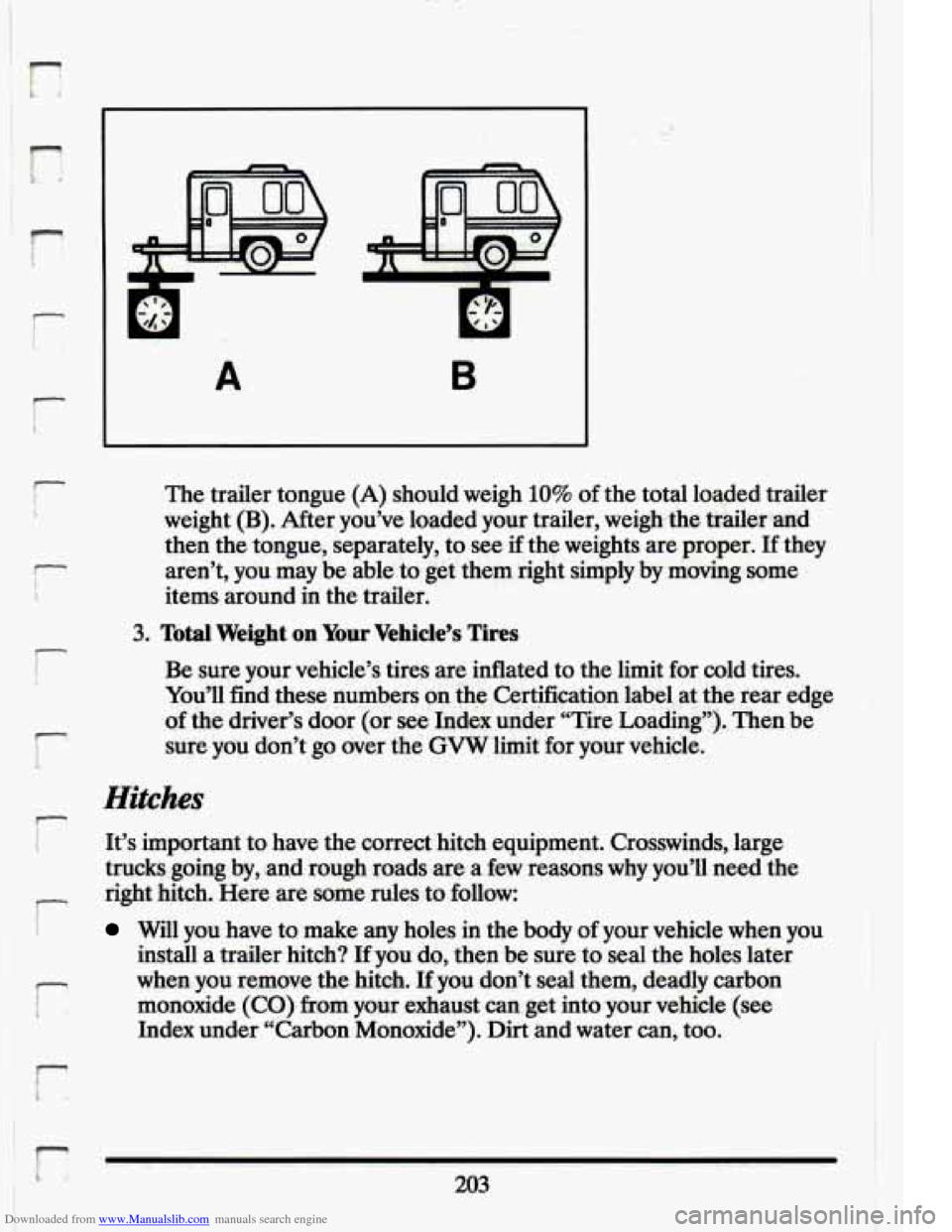
Downloaded from www.Manualslib.com manuals search engine P
r
r,
r
r
The trailer tongue (A) should weigh 10% of the total loaded trailer
weight
(B). After you’ve loaded your trailer, weigh the trailerand
then the tongue, separately, to see
if the weights are proper. If they
aren’t, you may be able to get them.right simply by moving-some
items around in the trailer.
3. Total Weight on Your Vehicle’s Tires
Be sure your vehicle’s tires are inflated to the limit for cold tires.
You’ll find these numbers on the Certification label at the rear edge
of the driver’s door (or see Index-under “Tire Loading”). Then be
sure you don’t go over the
GVW limit for your vehicle.
r !
Hitches
It’s important to have the correct hitch equipment. Crosswinds, large
trucks going by, and rough roads are a few reasons why you’ll need the
right hitch. Here are some rules to
follow:
Will you have to make any holes in the body of your vehicle when you
install a trailer hitch?
If you do, then be sure to seal the holes later
when you remove the hitch.
If you don’t seal them, deadly carbon
monoxide (CO) from your exhaust can get into your vehicle (see
Index under “Carbon Monoxide”). Dirt and water can, too.
r i. .,
203
Page 216 of 398
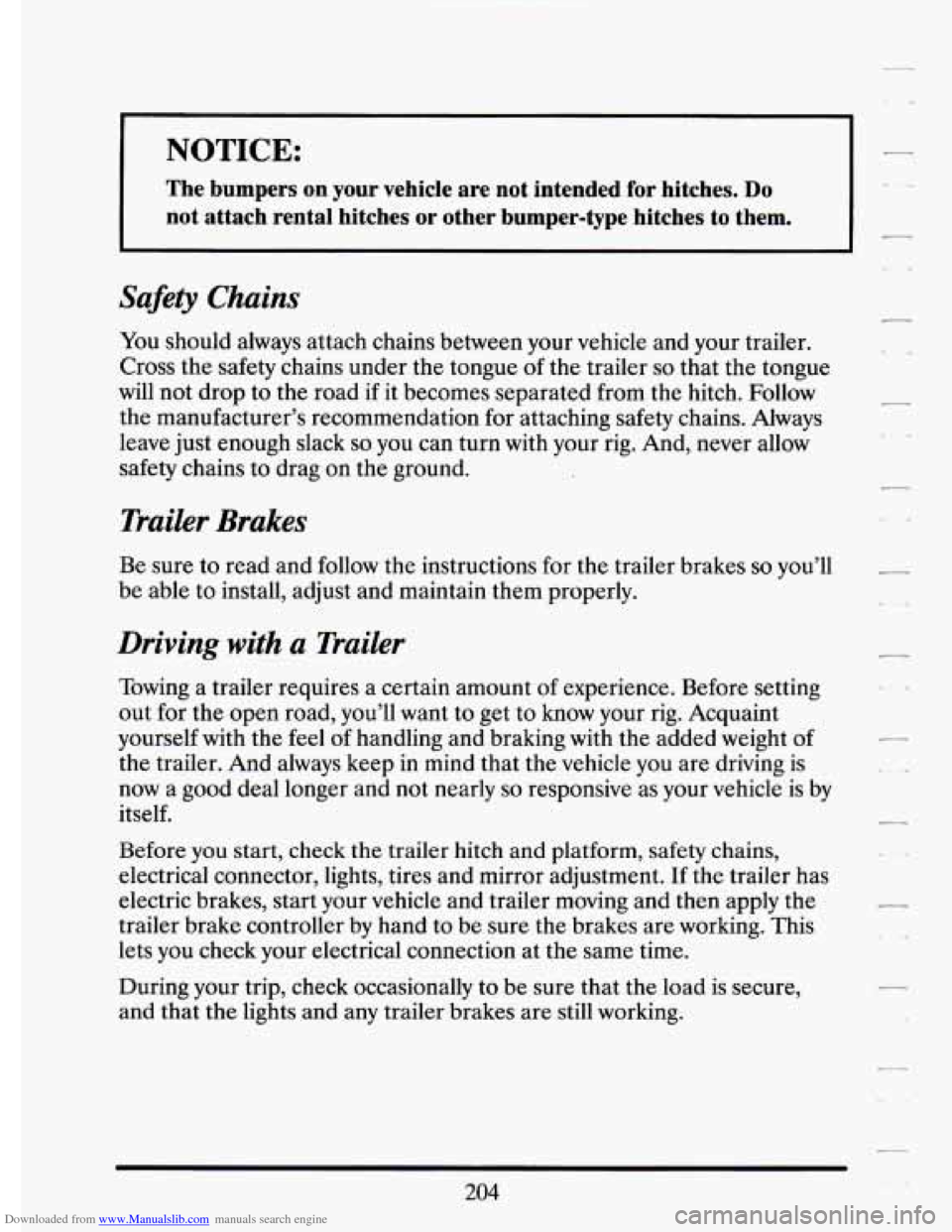
Downloaded from www.Manualslib.com manuals search engine NOTICE:
The bumpers on your vehicle are not intended for hitches. Do
not attach rental hitches or other bumper-type hitches to them.\
-
Safety Chains
You should always attach chains between your vehicle and your trailer.
Cross the safety chains under the tongue of the trailer
so that the tongue
will not drop to the road
if it becomes separated from the hitch. Follow
the manufacturer’s recommendation for attaching safety chains. Alwa\
ys
leave
just enough slack so you can turn with your rig. And, never allow
safety chains to drag on
the ground.
Trailer Brakes
Be sure to read and follow the instructions for the trailer brakes so you’ll -
be able to install, adjust and maintain them properly. L:
Driving with a Trailer
Towing a trailer requires a certain amount of experience. Before setting
out for the open road, you’ll want to get to know your rig. Acquaint
yourself with the feel of handling and braking with the added weight of
the trailer. And always keep in mind that the vehicle you are driving is
now a good deal longer and not nearly
so responsive as your vehicle is by
itself.
Before you start, check the trailer hitch and platform, safety chains,
electrical connector, lights, tires and mirror adjustment. If the trailer has
electric brakes, start your vehicle and trailer moving and then apply the
trailer brake controller by hand to be sure the brakes are working. This
lets you check your electrical connection at the same time.
During your trip, check occasionally to be sure that the load is secure,
and that the lights and any trailer brakes are still working.
204
Page 258 of 398
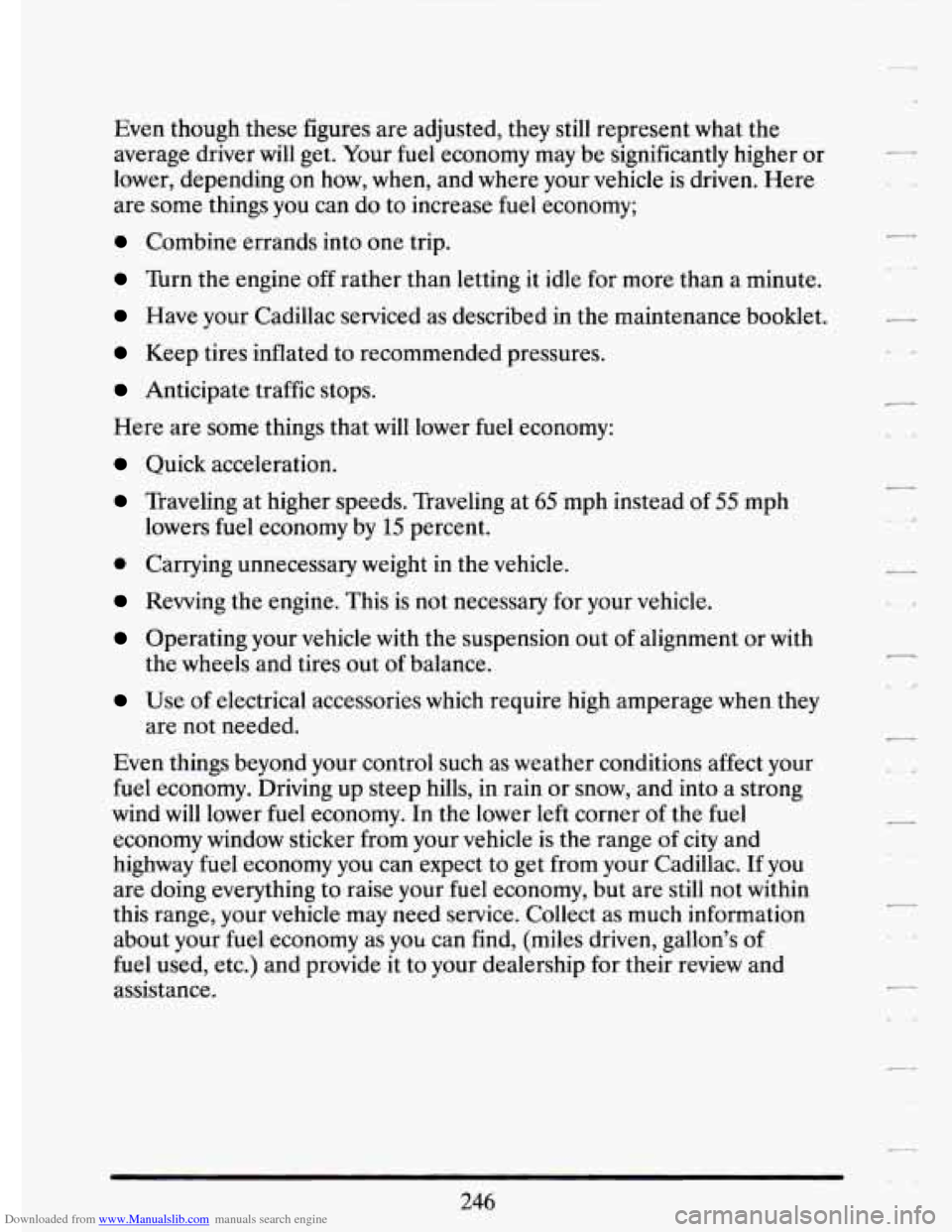
Downloaded from www.Manualslib.com manuals search engine Even though these figures are adjusted, they still represent what the
average driver
will get. Your fuel economy may be significantly higher or
lower, depending
on how, when, and where your vehicle is driven. Here
are some things you can do to increase fuel economy;
Combine errands into one trip.
Turn the engine off rather than letting it idle for more than a minute.
Have your Cadillac serviced as described in the maintenance booklet.
Keep tires inflated to recommended pressures.
Anticipate traffic stops.
Here are some things that
will lower fuel economy:
Quick acceleration.
Traveling at higher speeds. Traveling at 65 mph instead of 55 mph
0 Carrying unnecessary weight in the vehicle.
Rewing the engine. This is not necessary for your vehicle.
lowers fuel economy
by 15 percent.
Operating your vehicle with the suspension out of alignment or with
the wheels and tires out of balance.
Use of electrical accessories which require high amperage when they
are not needed.
Even things beyond your control such as weather conditions affe\
ct your
fuel economy. Driving up steep hills, in rain or snow, and into a strong
wind will lower fuel economy. In the lower
left corner of the fuel
economy window sticker from your vehicle is the range
of city and
highway
fuel economy you can expect to get from your Cadillac. If you
are doing everything to raise your fuel economy, but are still not within
this range, your vehicle may need service. Collect as much information
about your
fuel economy as you can find, (miles driven, gallon's of
fuel used, etc.) and provide it to your dealership for their review and
assistance. LA